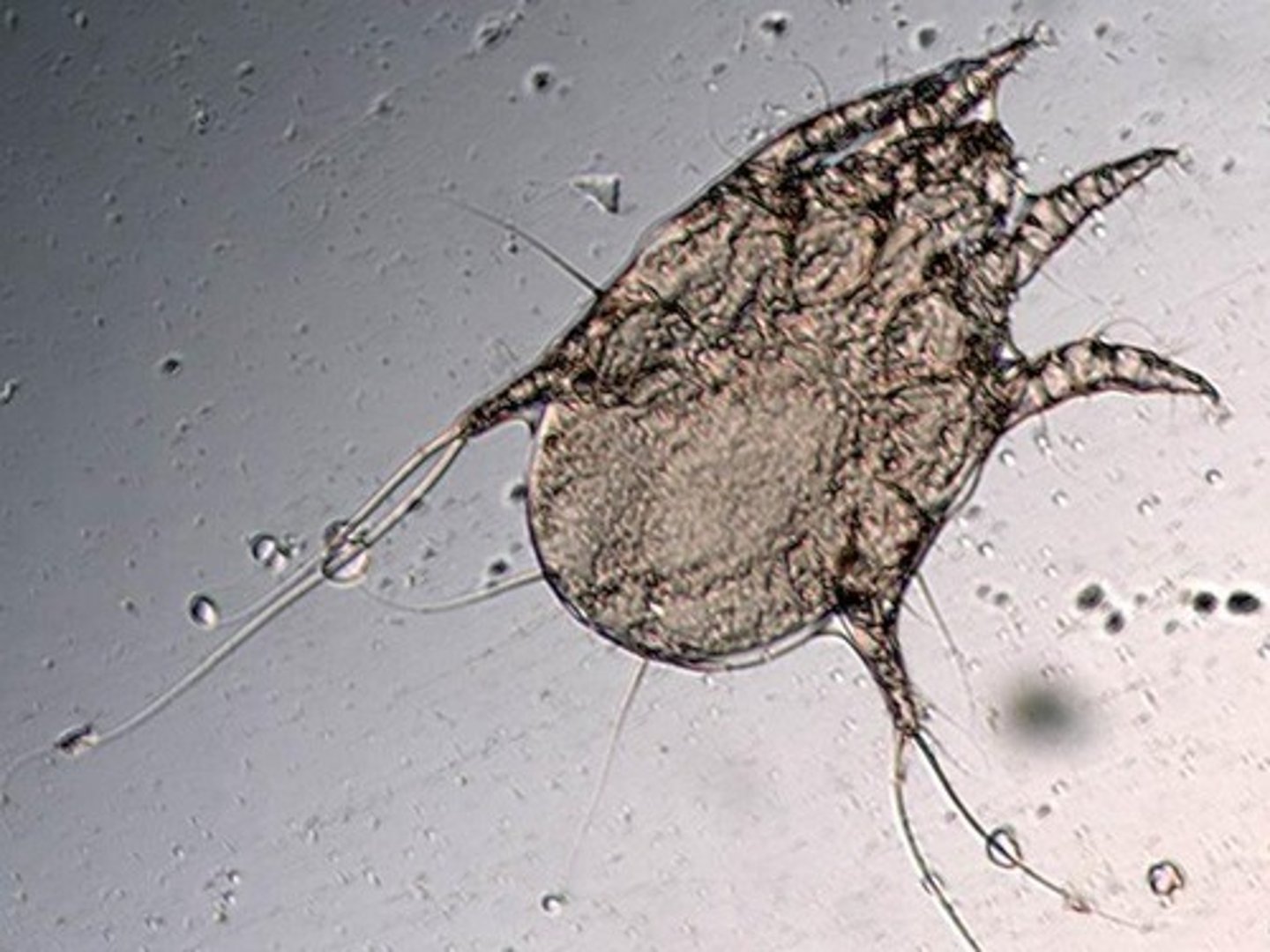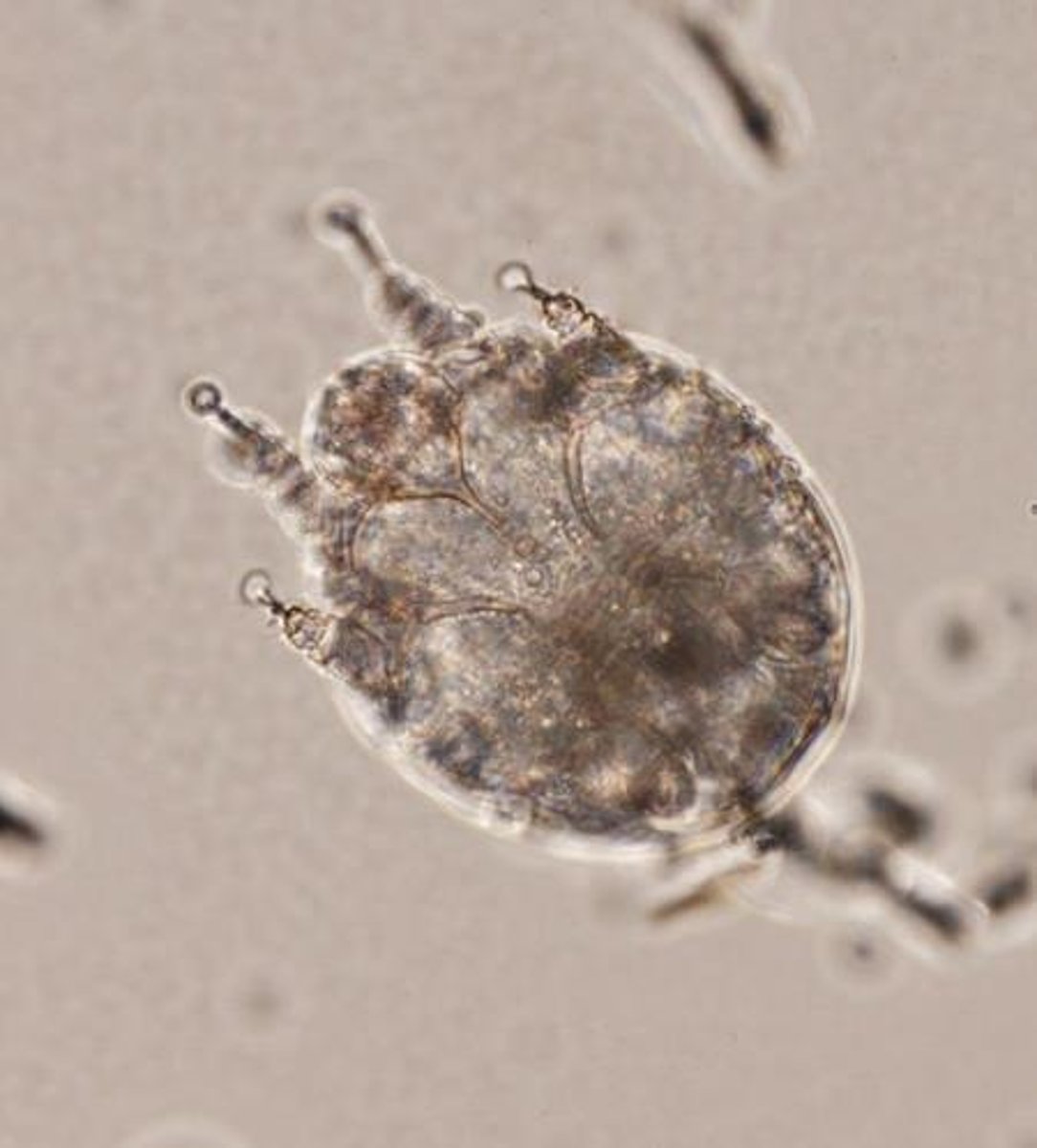Veterinary Parasitology: Mites Overview and Management
1/167
There's no tags or description
Looks like no tags are added yet.
Name | Mastery | Learn | Test | Matching | Spaced |
|---|
No study sessions yet.
168 Terms
OTODECTES CYNOTIS
Ear mite.
Mites
Arthropods that can be classified into sarcoptiform and non-sarcoptiform.
MITE CHARACTERISTICS
Microscopic structure with no eyes, specific leg positions, and mouthparts including palps, chelicerae, and chelae.
MITE LIFE STAGES
Includes egg, larvae, nymphs, and adults, exhibiting simple metamorphosis.
MITE LIFECYCLE
Mites have 6 legs.
Irritation secondary to biting/feeding
A problem associated with mites that causes discomfort due to their feeding behavior.
Persistent dermatitis from invasion
A skin condition that occurs as a result of mite invasion.
Mite-induced allergies
Allergic reactions triggered by the presence of mites.
Vectors and IHs
Organisms that transmit mites or serve as intermediate hosts.
Invasion of respiratory passages, ear canals, and potentially organs
Mites can invade various body systems, leading to serious health issues.
Acarophobia
An irrational fear of mites.
Delusional parasitosis
A psychological condition where individuals believe they are infested with parasites.
Non-'sarcoptiform' mites
Mite genera that do not belong to the sarcoptiform category.
'Sarcoptiform' mites
Mite genera that are classified as sarcoptiform.
Demodex
A genus of mites known for causing skin conditions in animals.
Sarcoptes
A genus of mites that includes Sarcoptes scabiei, known for causing mange.
Cheyletiella
A genus of mites that can affect the skin of animals.
Notoedres
A genus of mites that can cause skin issues in various hosts.
Dermanyssus
A genus of mites commonly known as the red mite.
Knemidokoptes
A genus of mites that can cause scaly leg disease in birds.
Ornithonyssus
A genus of mites that infests birds and mammals.
Otodectes
A genus of mites commonly known as ear mites.
Pneumonyssoides
A genus of mites that can infest the respiratory system of animals.
Psoroptes
A genus of mites that causes scab in livestock.
Trombicula
A genus of mites known as chiggers.
Chorioptes
A genus of mites that affects the skin of livestock.
Sarcoptic mange
A skin disease caused by Sarcoptes scabiei.
Transmission by 1° skin-skin contact
The primary method of transmission for Sarcoptes scabiei, occurring through direct contact.
Fomite transmission
Transmission of mites through contaminated objects, though less common.
Inflammation and Pruritus
Skin reactions characterized by redness and itching due to mite infestation.
Skin pathology - acanthosis
A condition involving thickening of the skin due to mite infestation.
Clinical signs appear ~10 days to 8 weeks after contact
The timeframe in which symptoms of Sarcoptes scabiei manifest after exposure.
2 negative skin scrapes a month apart is considered a 'parasitological cure'
A diagnostic criterion indicating successful treatment of Sarcoptes scabiei.
Humans acquire a self-limiting pruritus and rash that lasts for 12-14 days
The typical human reaction to Sarcoptes scabiei, which resolves on its own.
Notoedres cati
Sarcoptiform mite of cats, rats, rabbits.
Morphology of Notoedres cati
Long, unsegmented pedicels on short legs; smaller overall, anus is dorsal, no dorsal spines; 'thumbprint' pattern of folds (240 x 200 um).
Pathology of Notoedres cati
Face mange; pinna and spreads over face, paws, hindquarters; alopecia, hyperkeratosis, flaking, pruritus.
Clinical signs of Notoedres cati
Intense pruritus, alopecia & excessive crusts on face and ears, hyperpigmentation, secondary pyoderma and self-mutilation.
Diagnosis of Notoedres cati
Recover mites in superficial skin scrapings; clinical signs; mites are typically easily recovered compared to S. scabiei; Notoedres are found in groups 'nests' in tunnels.
Treatments for Notoedres cati
No FDA-approved treatments; Selamectin (Revolution®; Zoetis Animal Health) 6mg/kg spot-on; day 0, & 30 - single dose is 100% curative; Moxidectin/Imidacloprid (Advantage® Multi; Bayer) day 0, & 30 - single dose is 100% curative.
Public Health regarding Notoedres cati
Transient, opportunistic infestation in humans is possible (rare*).
Otodectes cynotis
Otodectic mange, Otoacariasis, Ear Mites.
Morphology of Otodectes cynotis
Developmental cycle: 3 wks; location - external ear canal (non-burrowing), head & neck; off host: up to 12 days; long legs, short, unsegmented pedicels on front pairs of legs; tan/sandy to dark ceruminous material in canals.
Pathology of Otodectes cynotis
Production of hypersensitivity; secondary infection - scratching; a few mites will produce otitis.
Clinical signs of Otodectes cynotis
Pruritic otitis externa; head shaking, scratching; brown crust or black coffee exudate.
Diagnosis of Otodectes cynotis
History; physical exam - otoscope; ear cytology.
Treatment for Otodectes cynotis
Clean ears! Several different commercial formulations for cleaning ears; several FDA approved treatments; miticidal otic preparations.
Knemidokoptes spp.
Hosts: poultry and other birds.
Morphology of Knemidokoptes spp.
Small, round mites; females lack pretarsi, males have long, unjointed stalks with pretarsi; short legs, adapted for burrowing; dorsal anus.
Life cycle of Knemidokoptes spp.
Entire life cycle occurs on the host; transmission by direct contact.
Pathology of Knemidokoptes spp.
Burrow into epidermis; hyperkeratosis (thickened, crusty skin).
Clinical signs of Knemidokoptes spp.
Scaly, crusty lesions on legs, feet, beak, and cere; beak deformities (especially in parrots & budgies); lameness or difficulty perching; feather loss around affected areas; secondary bacterial infections.
Diagnosis of Knemidokoptes spp.
History; skin scraping.
Treatment for Knemidokoptes spp.
Ivermectin (extralabel); isolate bird, environmental cleanup.
Public Health regarding Knemidokoptes spp.
Transiently zoonotic.
Sarcoptiform mites in livestock
Five genera of mites in cattle: Psoroptes sp.; Sarcoptes sp.; Chorioptes sp.; Psorergates sp.; Demodex sp (non-sarcoptiform).
Scabies mites
Three of these species are classified as scabies mites.
Lameness
Difficulty perching in birds.
Feather loss
Loss of feathers around affected areas in birds.
Secondary bacterial infections
Infections that occur as a result of primary conditions.
Diagnosis
Process of determining the nature of a disease.
History
Patient's past medical information used for diagnosis.
Skin scraping
A diagnostic procedure to collect skin samples.
Ivermectin
A medication used for treating parasitic infections, used extralabel in birds.
Environmental cleanup
Process of isolating birds and cleaning their surroundings.
Transiently zoonotic
Diseases that can be transmitted from animals to humans temporarily.
Sarcoptiform mites
Mites belonging to five genera found in cattle.
Psoroptes sp.
A genus of mites that includes species causing scabies.
Sarcoptes scabiei
A species classified as a scabies mite.

Psoroptes communis bovis
Common cattle scab mite, legally reportable in most states.
Chorioptes bovis
Common cattle scab mite, also legally reportable.
Transmission
The method by which a disease spreads.
Direct contact
Transmission through physical interaction.
Clinical signs
Observable symptoms of a disease.
Small papules
Small raised bumps on the skin, yellowish in color.
Hyperkeratosis
Thickening of the outer layer of skin.
Psoroptic mange
A type of mange caused by Psoroptes mites.
Chorioptes spp.
Mites that cause mange in various livestock.
Tail mange
Mange caused by Chorioptes bovis in cows.
Foot mange
Mange caused by Chorioptes ovis in sheep.
Diagnosis for Chorioptic mange
Clip hair and perform skin scraping.
Approved treatments for scabies mites
Ivermectin, Doramectin, Eprinomectin, Moxidectin, Amitraz dip, Coumaphos dip, Permethrin dip.
Demodex spp.
A genus of mites associated with demodectic mange.

Demodectic mange
A type of mange caused by Demodex mites.
Demodex Canis
A type of mite that lives in hair follicles and sebaceous glands, puncturing and feeding on cell contents.
Localized Demodectic Mange
A condition in dogs less than 1 year of age caused by short-term mite proliferation, self-limiting and not related to an immune defect or heredity.
Juvenile Onset Generalized Demodectic Mange
A condition in dogs less than 18 months of age characterized by excessive mite proliferation due to an inherited, cell-mediated immune deficiency.
Adult Onset Generalized Demodectic Mange
A condition in dogs older than 1 year of age associated with neoplastic processes or other debilitating diseases that result in immunosuppression.
Clinical Signs of Localized Demodicosis
1-5 well-demarcated areas of alopecia usually confined to areas around the lips, peri-orbital region, and forelimbs.
Treatment for Localized Demodicosis
Most cases resolve spontaneously with no intervention.
Clinical Signs of Juvenile Onset Generalized Demodicosis
Alopecia, erythema, seborrhea, edema, crusts, comedones, papules, pustules, draining tracts may be present.
Diagnosis of Demodex Canis
Deep skin scrapings are required, as the mite resides in hair follicles; a single mite does not confirm demodicosis.
Differentiating Localized vs. Diffuse Cases
Demodicosis is considered localized if there are no more than 4 lesions with a diameter of 2.5 cm in a puppy.
Signalment for Localized Demodicosis
Common in dogs less than 1 year of age, particularly purebred dogs.
Progression of Localized Demodicosis
Approximately 10% of localized demodectic mange can progress to Juvenile Onset Generalized Demodectic Mange.
Genetic Factors in Juvenile Onset Generalized Demodicosis
Appears to be associated with an autosomal recessive gene.
Immune Deficiency in Juvenile Onset Generalized Demodicosis
The immune deficiency leads to an overpopulation of mites, specific to the mite.
Breeding Recommendations for Juvenile Onset Generalized Demodicosis
Dogs diagnosed with this condition should not be used for breeding according to the ACVD.
Common Breeds Affected by Juvenile Onset Generalized Demodicosis
This disease is more common with certain breeds and lines, usually affecting multiple litter mates.
Clinical Signs of Adult Onset Generalized Demodicosis
Alopecia, erythema, and secondary infections may occur, often associated with underlying diseases.